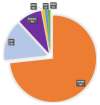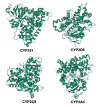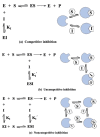Cytochrome P450 Enzymes and Drug Metabolism in Humans
- PMID: 34884615
- PMCID: PMC8657965
- DOI: 10.3390/ijms222312808
Cytochrome P450 Enzymes and Drug Metabolism in Humans
Abstract
Human cytochrome P450 (CYP) enzymes, as membrane-bound hemoproteins, play important roles in the detoxification of drugs, cellular metabolism, and homeostasis. In humans, almost 80% of oxidative metabolism and approximately 50% of the overall elimination of common clinical drugs can be attributed to one or more of the various CYPs, from the CYP families 1-3. In addition to the basic metabolic effects for elimination, CYPs are also capable of affecting drug responses by influencing drug action, safety, bioavailability, and drug resistance through metabolism, in both metabolic organs and local sites of action. Structures of CYPs have recently provided new insights into both understanding the mechanisms of drug metabolism and exploiting CYPs as drug targets. Genetic polymorphisms and epigenetic changes in CYP genes and environmental factors may be responsible for interethnic and interindividual variations in the therapeutic efficacy of drugs. In this review, we summarize and highlight the structural knowledge about CYPs and the major CYPs in drug metabolism. Additionally, genetic and epigenetic factors, as well as several intrinsic and extrinsic factors that contribute to interindividual variation in drug response are also reviewed, to reveal the multifarious and important roles of CYP-mediated metabolism and elimination in drug therapy.
Keywords: cytochrome P450; drug metabolism; genetic polymorphisms; protein structure.
Conflict of interest statement
The authors declare no conflict of interest.
Figures





References
Publication types
MeSH terms
Substances
Grants and funding
- 81773818, 81273596, 30900799, 81671326/National Nature Science Foundation of China
- 2016YFC0905000, 2016YFC0905002, 2016YFC1200200, 2016YFC0906400/National key research and development program
- 17PJD020/111 project, Shanghai Pujiang Program
- 13dz2260500/Shanghai Key Laboratory of Psychotic Disorders
- 20DZ2202000, 21002411100/Shanghai Science and Technology Innovation Fund
LinkOut - more resources
Full Text Sources
Medical

